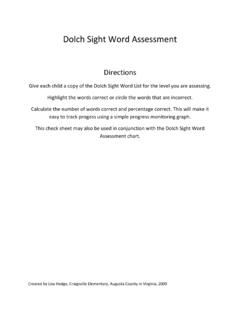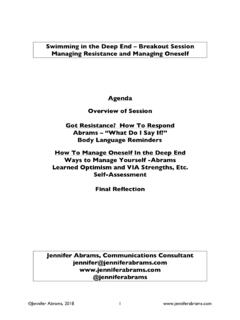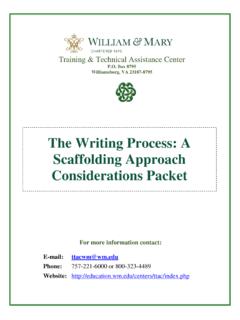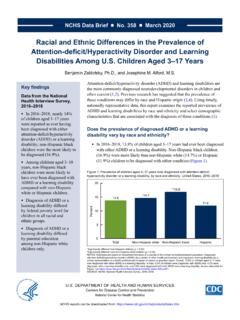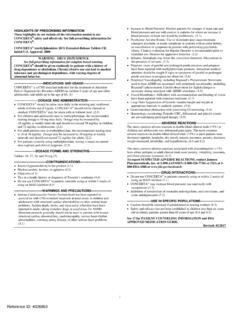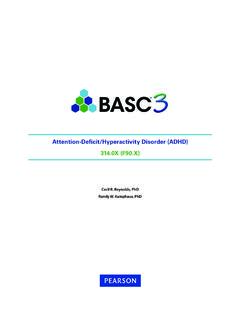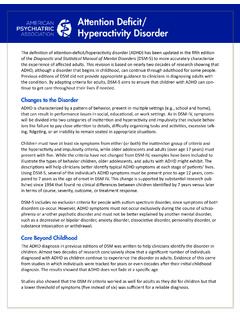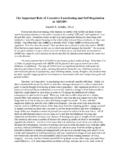Transcription of Training & Technical Assistance Center
1 Training & Technical Assistance Center Box 8795. Williamsburg, VA 23187-8795. Classroom Interventions for attention deficit /. Hyperactivity Disorder Considerations Packet For more information contact: E-mail: Phone: 757-221-6000 or 800-323-4489. Website: Classroom Interventions for attention deficit /Hyperactivity Disorder This packet focuses on classroom intervention strategies to enhance the learning environment for students with attention deficit /hyperactivity disorder (ADHD). An overview of ADHD is presented along with a brief description of the challenges students with ADHD typically demonstrate in the classroom. Strategies for academic interventions, behavior management, and home-school collaboration and communication are also included. Definition ADHD is one of the most commonly diagnosed conditions of children (Centers for Disease Control and Prevention, 2015). The diagnostic term attention deficit /hyperactivity disorder (ADHD) refers to individuals who display patterns of inattention, impulsivity, and overactive behavior that interfere with daily functioning (American Psychiatric Association [APA], 2013).
2 The Diagnostic and Statistical Manual (DSM) V (APA, 2013) criteria for diagnosing ADHD list three types of ADHD and the accompanying characteristics. Predominantly inattentive type. The student may: o submit inaccurate or incomplete work, o have difficulty attending to conversations, activities, or tasks, o be easily distracted, o have difficulty following directions, o frequently lose materials, and/or o have difficulty organizing tasks and materials. Predominantly hyperactive/impulsive type. The student may: o appear to be in constant motion, o frequently fidget or move in his or her seat, o become restless during quiet activities, o leave his or her seat when expected to remain seated, o interrupt others and classroom activities, o talk excessively, and/or o fail to follow classroom procedures ( , blurt out answers without raising hand). Combined type. The student may exhibit symptoms that include behaviors from both categories above. In order for a student to be diagnosed with ADHD, symptoms must appear before age 12 and be exhibited across at least two settings.
3 They must also have adverse effects on academic performance, occupational success, or social-emotional development (APA, 2013). To add to the complexity of the diagnosis, children with ADHD are likely to have co-existing emotional, behavioral, developmental, learning, or physical conditions (Wolraich & DuPaul, 2010). As a 2. Considerations: ADHD. T/TAC W&M, 1-800-323-4489. Updated July 2017. result of the behaviors listed above, students with ADHD are at greater risk of academic difficulties, social/emotional issues, and limited educational outcomes. The degree to which attention impacts a student's academic and social performance is related to the interactions between the student's academic and behavioral needs and the environmental demands. Therefore, it is not unusual for the student to perform differently across settings. For example, a student with ADHD may experience academic success in elementary school;. however, when he enters middle school, the increased academic and organizational demands may increase his need for additional academic and behavioral supports.
4 Intervention Goals School interventions should include a team approach across multiple settings, consisting of both preventive and intervention strategies. Interventions must be based upon assessment data that includes information about the student's strengths and needs as well as the environmental conditions in which her characteristics of ADHD occur. Progress monitoring and strategy adjustments are critical to the success of any intervention plan (Wolraich & DuPaul, 2010). Academic Interventions The first step in creating classroom supports for students with ADHD is understanding the students' strengths and needs. This involves formal and informal assessment, as well as collaboration among educational professionals and the students' families. If a student is not responsive to behavioral strategies and interventions, more intensive interventions, such as functional behavior assessment and behavior intervention plans, should be considered (see Practical FBA).
5 No one intervention is universally effective for all students with ADHD. A. combination of research-based and promising practices is recommended. Several of these practices are described below. Giving Directions Many students with ADHD have trouble following directions. The guidelines below help address this problem. o Number of Directions: Give a minimal number of directions or steps at a time. If necessary, have students repeat the directions to the teacher or a peer partner. o Form of Directions: Provide written directions or steps, or a visual model of a completed project. Teach students how to refer to these items as reminders of process steps to complete tasks. This strategy is particularly helpful for long-term projects. Written Assignments Many students with ADHD have particular challenges with written work due to fine- motor skills difficulties, motor planning issues, and difficulty alternating their attention 3. Considerations: ADHD. T/TAC W&M, 1-800-323-4489.
6 Updated July 2017. from a book to their written responses. Students with ADHD may also need Assistance breaking a larger task or project into smaller, more workable units. The following strategies can be used to address these needs. Deconstructing Tasks: Break tasks into smaller units. o Limit amount of work per page. o Cover up part of the work on a page. o Allow extra time for completing tasks. o Provide work breaks. o Allow student to use a computer to type or to use speech-to-text software. o Reduce the length of written assignments. Organization Many students with ADHD have significant difficulties with organization. They are more likely to respond positively when teachers establish class routines and set procedures and maintain a well-organized learning environment. Clear rules and advanced planning are keys to success for teachers of students with ADHD. The following organizational supports are particularly useful. Students should be taught to use these tools through teacher modeling and guided practice with feedback before being expected to use them more independently.
7 O Assignment Notebook: Provide the student with an assignment notebook to help organize homework and seatwork. o Color-Coded Folders: Provide the student with color-coded folders to help organize assignments for different academic subjects. o Homework Partners: Assign the student a partner who can help record homework and other seatwork in the proper folders and assignment book. o Clean Out Dates: Periodically ask the student to sort through and clean out his or her desk, book bag, and other special places where written assignments are stored. o Extra Books: Provide the student with an extra set of books or electronic versions of books for use at home. This eliminates the student having to remember to bring books back and forth. o Use of Calendars: Teach the student to use a calendar for scheduling assignments. Tape a schedule of planned daily activities to the student's desk to help with time management and transitions. o Checklist of Homework Supplies: Give the student a checklist that identifies categories of items needed for homework assignments.
8 The checklist can be taped to the inside of the student's locker or desk. 4. Considerations: ADHD. T/TAC W&M, 1-800-323-4489. Updated July 2017. Classroom Considerations The culture of the classroom can either support or create barriers to student success (Piffner, 2011). Factors that foster attention , positive behavior, and academic and social success include establishing positive relationships with students, adopting classroom management techniques, and creating a physical arrangement that facilitates learning. It is often a positive relationship with one teacher that facilitates school success for a student with ADHD (Piffner, 2011). When teachers connect with students and appreciate their unique skills and interests, students are more likely to strive for achievement and positively respond to classroom rules and procedures. When using a proactive approach to classroom management, teachers support all students and create conditions that prepare them for learning (Piffner, 2011).
9 Some strategies for positive management include clear directions, meaningful feedback, and opportunities for collaboration with peers. Additional strategies are noted below. Opportunities to Respond Students with ADHD often have the most trouble attending during drill-and-practice assignments because of the repetitive nature of the tasks. Peer-mediated approaches such as those enumerated below are particularly effective for students with ADHD in such cases, because they increase students' opportunities for engagement and active learning (Piffner, 2011). In creating peer-mediated activities, the teacher may need to choose students whose skill levels complement each other. Students with and without attention difficulties and impulsivity should be considered for peer partnerships. o Peer Tutoring: Peer tutoring is one of the more effective strategies for students with ADHD, because it provides many of the same supports as one-to-one instruction. It facilitates the acquisition of both academic and social skills.
10 Peer tutoring is most effective when Training is provided to participating students (Piffner, 2011). Tutors need to be taught how to be prepared with materials needed for the session and how to give positive and corrective feedback to their partner (Greenwood & Delquadri, 1995). o Cooperative Learning: Carefully structured cooperative learning groups in which each student is assigned a role and has clear expectations for desired outcomes are very helpful for students with ADHD. The more structured the cooperative activity, the more likely it is that these students will succeed. o Sharing Strategies: Think, Pair, Share/Square Share/Group Share: Using this approach, students work with peer partners to discuss the lesson, check each other's work, and share strategies. 5. Considerations: ADHD. T/TAC W&M, 1-800-323-4489. Updated July 2017. o Partner Reading: Student partners take turns reading orally and listening to each other. Peer partners can also be helpful with discussing answers to comprehension questions, spelling, proofreading, and solving math problems.

